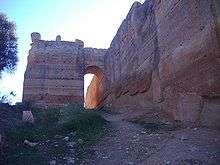Albarrana tower



An Albarrana tower (from the Arabic word barrani = exterior) is a defensive tower detached from the curtain wall and connected to it by a bridge or an arcade.[1]
They were built by Muslims when they occupied Iberian Peninsula between the 8th and the 15th centuries, especially from the 12th century during the Almohad dynasty and mainly in the south of Spain and Portugal where the Islamic influence was the longest. In Spanish, they are called torre albarrana.[1]
The towers of typical appearance, with a square section, were built several meters in front of the curtain wall. They were accessible by a bridge walkway from the curtain wall. More often, the bridge had a removable wooden section allowing the tower to be isolated from the wall if the tower is occupied by attacking forces. The earliest Albarrana towers were often pentagonal or octagonal in plan (e.g. Badajoz, Tarifa, Seville) but a more rectangular plan became the norm. [1]
In France and the north of Europe, flanking towers remained a part of the wall. Even the keep were sometimes built as a part of the wall instead of inside the yard at the center of the castle. They were philippian towers.
The main albarrana towers are :
- Torre de Espantaperros in Badajoz, Spain. Probably the first albarrana tower, built by Abu Yaqub Yusuf in 1170. Its plan is octagonal.[1]
- Torre del Oro, Torre de la Plata in Sevilla
- Torre de la Malmuerta in Cordoba
- Town of Talavera de la Reina near Toledo with several albarrana towers
- Òdena castle near Barcelona
- Castle of Paderne in Portugal
- 2 albarrana towers in the Santa Catalina castle in Jaén
- Castle of Loulé in Portugal
Albarrana towers are almost uniquely confined in the Iberian Peninsula. In the other parts of the medieval Muslim world this defensive feature seems not to be used.[1]

Possibly the only example of a true Albarrana tower in England can be found at Pontefract Castle. The castle now lies in ruins, but one Albarrana tower called Swillington Tower is visible on the models of the castle and the remains of the tower itself can be seen to the north of the castle.[1]
References
- 1 2 3 4 5 6 Burton, Peter, Torre Albarrana, Castles of Spain, archived from the original on 6 June 2014, retrieved 29 July 2014
Further reading
- Burton, Peter (2007–2008), "Islamic Castles in Iberia" (PDF), The Castle Studies Group Journal, 21: 228–244
- Burton, Peter (2011), "Islamic Castles in Iberia", Postern, 21
External links
| Wikimedia Commons has media related to Albarrana tower. |
- (Spanish) http://www.elperiodicoextremadura.com/noticias/noticia.asp?pkid=435528
- https://web.archive.org/web/20140606060349/http://castlesofspain.co.uk/TorreAlbarrana.html